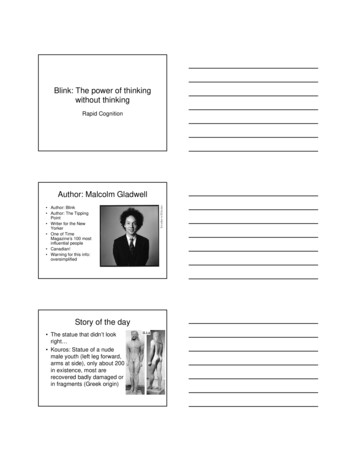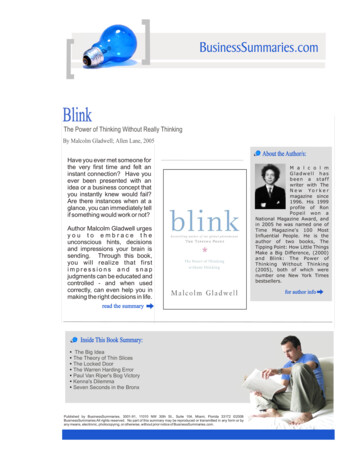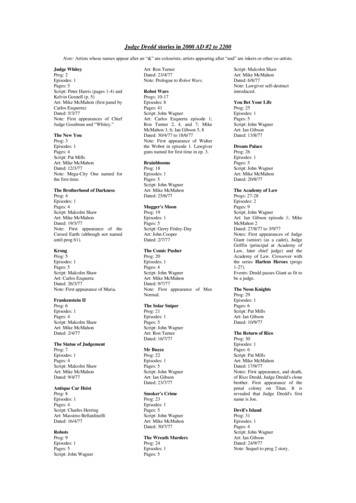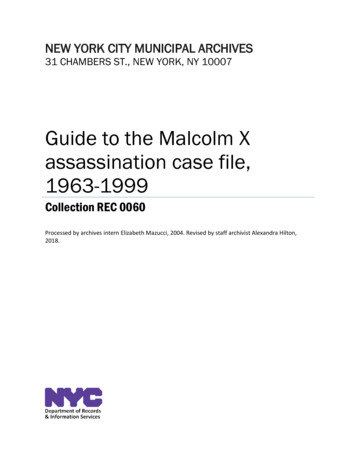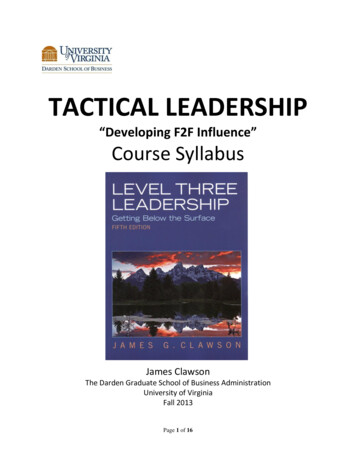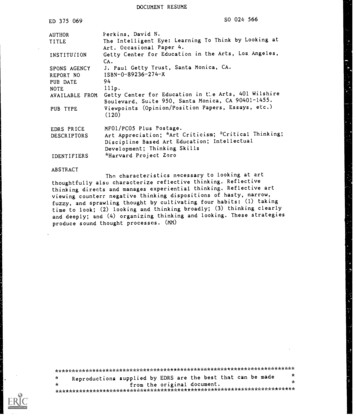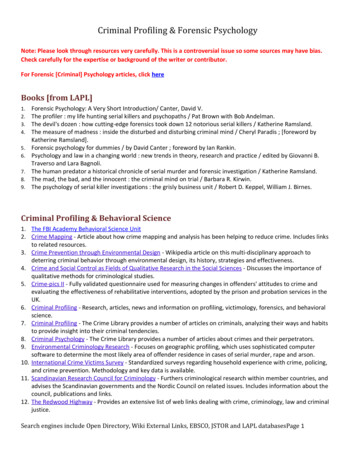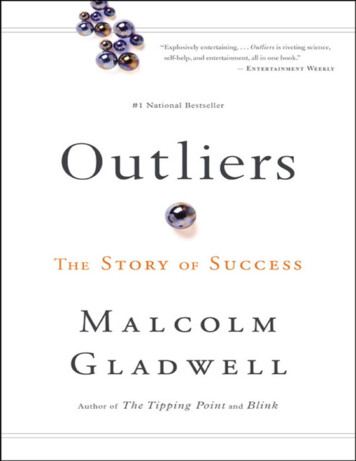
Transcription
Author: Malcolm GladwellBlink: The power of thinkingwithout thinkingRapid CognitionStory of the day The statue that didn’t lookright Kouros: Statue of a nudemale youth (left leg forward,arms at side), only about 200in existence, most arerecovered badly damaged orin fragments (Greek origin)Kouros Statue was made of dolomite marble andwas covered by a layer ofcalcite important because dolomite turnsinto calcite over the course of hundreds orthousands of years didn’t appear to be acontemporary fake The kouros was purchased by themuseum after a 14 month investigation Author: Blink Author: The TippingPoint Writer for the NewYorker One of TimeMagazine’s 100 mostinfluential people Canadian! Warning for this info:oversimplifiedKouros In 1983, an art dealer claimed he had aperfectly preserved Kouros which he triedto sell to the J. Paul Getty museum for 10million dollars The museum proceeds slowly, runningmultiple tests on the kourosProblem: The statue didn’t look right One art historian first noted this while staring at thefingernails of the statue but couldn’t articulate theproblem An expert on Greek sculpture also felt it was fake themoment she saw it but wasn’t sure why A former museum director noted that his first thoughtupon seeing the statue was “fresh”, not the expectedreaction to a 2000 year old statue No one could articulate the problem, every one of theseexperts, however, had an instinctive sense that thestatue was a fake
The statue was sent to Athens to beinvestigated by the foremost sculptureexperts Every expert thought something waswrong on first glance but couldn’t articulatewhy One expert noted that on first glance, hefelt “intuitive repulsion” Still, all scientific tests on the authenticityof the statue checked out Soon, however, the case falls apart theauthenticity of documents called intoquestion (postal code), incredibly carefulexamination showed that the design of thekouros mimicked several different stylesand time periods Later analyses showed that you could agethe surface of dolomite marble using apotato mold Statue turned out to be a modern forgery None of this would have been discoveredin the absence of “intuitive repulsion” thatoccurred in many the first moment theyglanced at the statueMother always told us An example Haste makes wasteLook before you leapStop and thinkDon’t judge a book by it’s cover Picture a gambling game in which you arefaced with 4 decks two red and two blue Each card in each deck either wins youmoney or costs you money, your task is tomaximize winnings and minimize losings We’re taught that we’re better off gathering asmuch information as possible and spending asmuch time deliberating as possible but is it thecase that doing so is actually a bad idea?An example What you’re not told: the red decks are aminefield high rewards but when youlose you lose big The only way to win is by taking cardsfrom the blue decks, steady payouts, lowpenalties How long will it take you to figure that out? Most people figure out how to play afterturning over 50 cards but can’t articulatethe rules After 80 cards, you’ve figured out thegame and can explain why to avoid certaindecks This makes sense, it’s learning we haveexperiences, think them through, and drawconclusions What if we measure knowledge in adifferent way though (similar to implicitlearning)
Participants are hooked up to a machinethat measures activity of the sweat gland,below the skins in the palm of their hands(skin conductance responds to stress aswell as temperature) Stress responses are generated to the reddecks after only 10 cards are turned over,40 cards before conscious knowledgekicks in After 10 cards people draw from the bluedeck moreso People have actually figured the game outwell before they know they have In a high stakes situation where a lot ofinformation is being taken in in a short period oftime, our brain uses two very different strategiesto make sense of the world 1) Conscious strategy – we think about whatwe’ve learned and reach a logical and definitiveconclusion, but it takes us awhile to get to thispoint (slow moving) 2) Unconscious strategy – operates far morequickly, very smart, identifies patternsimmediately, the only downside is we’re notaware of it It’s the second strategy that influenced theexperts examining the kourosThe Adaptive UnconsciousThe Adaptive Unconscious The part of our brain that leaps towardsconclusions (not to be confused withFreud’s notion of unconscious) Essentially a giant computer that quicklyand quietly processes a lot of informationto allow us to function normally Quick decision making process What do you do when a truck is bearingdown on you or someone throws a punchat you?How quickly can you determine aprofessor’s teaching effectiveness? Ambady & Rosenthal (1993) Students shown a 10 second, 5 second, or2 second clip of a professor with the soundturned off and are asked to rate teachingeffectiveness Ratings compared with ratings at the endof the semester No difference in ratings The mind operates efficiently by leaving alot of high-level sophisticated thinking tothe unconscious much like pilots planescan fly on autopilot Adaptive unconscious sizes up world,warns of us dangers, sets goals andinitiates actions We tend to switch back and forth betweenconscious and unconscious modes ofthinkingRapid cognition We tend to be suspicious of rapid processingdue to how we’re taught to think (more research,more tests, etc.) Present purpose– 1) To convince you that the decisions we makerapidly are often as good as those we make after agood deal of time and thought– 2) To determine the situations in which ourunconscious fails us (why did that museum purchasethe kouros?)– 3) Snap judgments can be controlled and we canteach ourselves to make better snap judgments
How rapid cognition applies Decision makingAttentionAutomaticityExpertiseThin slicing: a little knowledge goesa long way John Gottman,Washington University Marital stability andrelationship analysis Claims to be able toassess the likelihood ofdivorce just bywatching briefinteractionsWhat can be learned in 15minutes? Can you tell if someone’s marriage ishealthy/unhealthy when viewing themhaving a discussion about a single topic? To really know a couple, wouldn’t youneed to see them interact over time indifferent situations? Gottman says no, 15 minutes is all it takesto predict future relationship successKeep in mind our unconscious is powerful, but fallible,it can be thrown off, our instinctivereactions can go awry Normally when this happens though,there’s a reason Couples seated on chairs facing eachother with electrodes and sensors clippedto their fingers and ears (measures heartrate, skin temperature, sweat) Chairs are motion sensitive to determinehow much people move around Videotape interactions in which couple isasked to talk about a contentious issuefrom their marriageSPAFF Gottman analyzes all interactions withSPAFF (specific affect), a coding systemwith 20 categories corresponding to anyemotion that may be expressed during theconversation (e.g. contempt is 2, anger is7, defensiveness is 10) Students code every second of everyinteraction The coded information is then added to anequation that also factors in the data fromthe electrodes and sensors
How much can you tell from thedata? If you look at one hour of interaction,ability to predict whether the couple willstill be together in 15 years is 95% If you look at 15 minutes, can still predictwith up to 90% accuracy Even after viewing only 3 minutes, yourability to predict marriage stability is quitehigh How can one be so accurate with littleinformation?Thin-slicing A critical aspect of rapid cognition Thin-slicing is the ability of ourunconscious to find patterns in situationsand behaviors based on narrow slices ofexperience When our unconscious thin-slices, it isdoing an automated, accelerated,unconscious version of what Gottmandoes with his videotapes and calculationsThin slicing Expertise comes about due to expertise What Gottman is able to do comes about due tohis years of experience coding tapes Claims he can now here couples discuss thingsover dinner and know whether or not they’llmake it Our unconscious is able to thin slice for thesame reason, lots of experience with thingsmakes them automatic (like driving a car) As people become experienced at codingSPAFF, patterns of behavior jump out thatwouldn’t be perceived otherwise (e.g., eyerolling, word choices, yes-but, tone) What is actually being measured ispositive and negative emotionindependent of what is said interactionsthat appear positive can actually be verynegativeExpertiseWhat exactly is our unconsciousbasing it’s decision on? As people become experienced at codingSPAFF, patterns of behavior jump out thatwouldn’t be perceived otherwise (e.g., eyerolling, word choices, yes-but, tone) What is actually being measured ispositive and negative emotionindependent of what is said interactionsthat appear positive can actually be verynegative Fists – distinctive patterns A fist is a term used in Morse code, eventhough dots and dashes are standard,everyone has their own specific fist – dotsand dashes are formed with variousspacing and rhythm for each individual
What exactly is our unconsciousbasing it’s decision on? In WW2, the British were able to learn about theGermans by analyzing fists rather than particularmessage content (certain operators were withcertain units and by determining their fist theycould pick up on where each unit was at a giventime) Critically: fists emerge naturally, your personalitytends to express itself automatically andunconsciouslyContempt Contempt also correlates with the number ofcolds a husband/wife gets in a year being inthe presence of contempt is so stressful it candamage your immune system This seems to be how our unconscious works:when we leap to a decision our unconscious isthrowing out irrelevant info and zeroing in on theimportant stuff As a result thin-slicing is sometimes better thandeliberative/exhaustive thinkingSamuel Gosling Uses the Big 5inventory to studypersonality– Extraversion– Agreeableness– Conscientiousness– Emotion Stability– Openness to newexperiences Relationships also have fists which areexpressed during interactions, one needs toknow how to pick up on them Turns out that there are shortcuts to this as well Selectivity is key (picking up on the mostimportant determinants) For relationships, there are 4 critical negativepredictors: defensiveness, stonewalling,criticism, and contempt Contempt is by and large the most importantdeterminant of marital stability (contempt isessentially any statement of superiority, madefrom a higher level)Another example If you’re going to hire someone for a job,what’s the more effective approach?– A) Meet with the prospective hire twice aweek for a year– B) Go to his/her house and spend a half hourlooking around We’re generally taught that option a) iscorrectGosling et al., 2002 80 subjects all of whom fill out a questionnairetapping into the Big Five The subjects then select their closest friends tofill out the same questionnaire describing them Then the experimenter took strangers who hadnever met the students, gave them the samequestionnaire (is this person talkative, original,reserved, etc.), and asked them to fill it out afterspending 15 minutes looking through thesubjects dorm room (no interaction withindividual)
How does everyone do Friends describe us accurately How about strangers:– Not good at determining extraversion (really need tointeract with someone to determine this)– Slightly less better than friends at determiningagreeableness (also probably need to interact withsomeone)– For the other three scales though (conscientiousness,emotional stability, openness to experience),strangers are actually more accurate than friends– Overall, strangers rate us better than our friends do– This is another example of thin-slicingMore importantly, what informationdo you not get from a bedroom? When you meet someone face to face anumber of confusing, complicated, andirrelevant pieces of information can beobtained which mess up your judgment(e.g., if you met a football player who wasa philosopher, could you get by the dumbjock bias what if you just saw hisbookcase?)Yet another example Imagine you work for an insurancecompany that sells medical malpracticeprotection it is your job to determinewhich physicians are most likely to besued .do you– A) examine each physicians’ training andcredentials, analyze past performance forerrors– B) Listen in on brief snippets between eachdoctor and his/her patientWhat can a bedroom tell you? Three kinds of clues about personality– Deliberate expressions of how we’d like to beviewed by the world (e.g., framed degree)– Behavioural residue: inadvertent clues suchas dirty laundry or alphabetized CD collection– Thought and feeling regulators: scentedcandles, decorative pillows People aren’t very good at being objectiveabout their own personality, they may lie,so we ask questions to get around thisrather than straightforward questions (e.g.what is your marriage like) Strangers can cut through this by simplyobserving your room, Gottman cutsthrough this by examiningpositive/negative nature of interactionsindependent of content of interactionsWhy people sue Often times shoddy medical care goesunpunished, people sue because ofshoddy medical care plus something else Physician demeanor: physicians who takemore time answering questions in afriendly/gentle tone are rarely sued, thosewho are rushed, blunt, or unclear, areoften sued
Levinson et al., 1997 What differentiates surgeons who have neverbeen sued relative to those who have been suedtwice or more? Surgeons who have never been sued – Spend about 3 minutes more with each patient– More likely to make orienting comments (first I’ll dothis, then that)– More likely to engage in active listening– Importantly, however, no difference in quality ofinformation/care given by those who have been suedrelative to those who have notAmbady et al., 2002 Subjects asked to rate each clip for warth,hostility, dominance, and anxiousness From those ratings you can predict, with ahigh probability, who will be suedThe secret life of snap decisions Vic Braden, formerprofessional tennis playerand top tennis coach While watching tennismatches, knows instantlywhen a player is about todouble fault Has no idea why he knowsthis even though he cancorrectly call out doublefaults almost every time theyare about to happen (16 outof 17 over the course of oneweekend)Ambady et al., 2002 Took two 10-second clips of interactionsbetween physicians and patients Content filtered the clips to remove abilityto recognize individual words, butintonation, pitch, and rhythm arepreservedThin slicing Related to other concepts– Court sense in basketball– Love at first sight– Coup d’oeil in the military (power of theglance)– “I knew the moment I saw him/her ”– Internet dating, speed datingExpertise Braden has become so expert at pickingup the subtle nuances of tennis he has thisknowledge but is frustrated that he can’tverbalize why What does this tell us about snapjudgments?– They are almost entirely unconscious (e.g. thegambling experiment where people learnabout the red decks way before they areconsciously aware that they learned)
Kouros When the experts knew the kouros was a fake,they couldn’t verbalize why either Art critic Bernard Berenson: “distressedcolleagues due to his inability to articulate howhe could clearly see the defects andinconsistencies of a particular work”– His common explanations My stomach felt wrongI had a ringing in my earsI was struck by momentary depressionI felt woozy and off balanceOkay, so our unconscious makessnap judgments, is there any way forus to influence our unconscious? John Bargh Social Psychologist Has investigatedpriming effects onbehaviour George Soros, a billionaire investor, usedto say he’d change positions on themarket when his back hurts How many investors would you trust whotold you they based things on their soreback? Snap judgments take place behind alocked door that we don’t deal with verywell (seemingly no key)Bargh et al., 1996 Scrambled sentence test: create one four word sentencefrom each set of words as quickly as possible––––––––––him was worried she alwaysfrom are Florida oranges temperatureball the throw toss silentlyshoes give replace old thehe observes occasionally people watchesbe will sweat lonely theysky the seamless grayshould now withdraw forgetful weus bingo sing play letsunlight makes temperature wrinkle raisinsBargh et al., 1996Bargh et al., 1996 The sentence task is actuallyirrelevant interest is in how fast/slowpeople leave the experiment relative tohow fast/slow they came After the sentence task people take longerwalking back down the hall than they tookwalking in Priming “old” is supposed to have madepeople walk slowly Scrambled sentence test: create one four word sentencefrom each set of words as quickly as possible––––––––––him was worried she alwaysfrom are Florida oranges temperatureball the throw toss silentlyshoes give replace old thehe observes occasionally people watchesbe will sweat lonely theysky the seamless grayshould now withdraw forgetful weus bingo sing play letsunlight makes temperature wrinkle raisins
Works for other behaviours alsoRelated findings Sentence test has words related to either beingrude (aggressive, bold, rude, bother, disturb) orpolite (respect, considerate, patiently, yield,polite) After task, subjects are asked to walk down thehall and get the experimenter who is engaged ina conversation with someone else Those primed to be rude interrupted around 5minutes into the conversation Those primed to be polite never interrupted 82%of the time (10 minute max) Subjects asked to answer 42 Trivial Pursuitquestions Prior to this, half of all subjects are asked tothink about what it would mean to be a professorand write down everything that came to mind Other half of subjects were asked to think aboutsoccer hooligans “Professor” group outperforms “hooligan” groupon trivia questions (56% vs. 42% correct)Steele & AronsonFree will? Subjects: black college students Test: 20 questions drawn from the GRE Prior to the GRE questions, half of all subjectsare asked to identify race (primes stereotypes ofAfrican Americans?) People asked about their race do half as well assubjects who weren’t All subjects indicated that it hadn’t botheredthem to be asked about their race pre-test In all of these examples people have no idea theprime is influencing themFree will? Yes, we’re hardwired to perform optimallyacross environments, if we carefullyanalyzed everything around us we’d neverget anything done your unconsciouspicks up on clues about the environmentand tells you how to act accordingly soyou needn’t wastetime/resources unconscious is like amental valet Is free will an illusion? The resultssuggest that much of the time we operateon autopilot and we’re influenced by farmore variables than we could imagine Is there an advantage to operating likethis?What if our unconscious didn’t actthis way? Damasio has studied a patient with damage tothe ventromedial prefrontal cortex (area criticalto decision making) Highly intelligent, high functioning individual wholacks judgment Takes about 30 minutes to decide between twopotential dates for an appointment (considersprevious engagements, proximity to otherengagements, weather, etc.)
Gambling experiment When this patient does the red deck/bluedeck experiment he learns the same aseveryone else but don’t show any of thephysiological symptoms early on (e.g.sweaty palms) Can’t verbalize at any point why the bluedeck is better either Lacks the same mental valet the rest of ithas and it affects performanceThe Warren Harding Error (tall darkand handsome) Problem: Harding was not very intelligent(pompous and not particularly wellspoken), spent most of his time playingpoker and golf, and had a voracioussexual appetite that got him into a fairamount of political troubleThe dark side of thin slicing Though thin slicing can be helpful, it mustalso be acknowledged that it is notinfallible Thin slicing is at the root of mostprejudice/discrimination It’s why picking a job candidate is difficultand why sometimes, very mediocre peopleend up in positions of enormousresponsibilityThe Warren Harding Error (tall darkand handsome) In 1899, Harding was asenator in Ohio who wasmet and befriended bypolitical advisor HarryDaugherty Daugherty’s initialimpression was thatHarding would make a goodpresident (based on thislooks, tall, chiseled,handsome) Many others agreed,thought he looked noble(Roman)He looked like a presidentialcandidate Despite his shortcomings, he wascontinuously pushed up the political ladderbased on his look Unfortunately, Harding is considered on ofthe worst presidents in American history This is the dark and unfortunate side ofthin slicingThe dark side of thin slicing In order to take rapid cognition seriously,we need to accept the fact that in somesituations, rapid cognition leads us astray Numerous researchers have begunexamining these unconscious/implicitassociations which influence our beliefsbehaviour
Example 1The Implicit Association Test (IAT) Based on the idea that we makeconnections more quickly between pairs ofideas that already related in our mindsthan we do pairs that are unfamiliar to us How do we use this knowledge to testimplicit associations?MaleExample 2Male or careerFemale or yJoanDerekPeggyJasonLisaFemaleExample 3Male or familyFemale or icJoanAnother exampleIAT People tend to be much faster completingexample 2 relative to example 3 because mostpeople have stronger associations betweenmaleness and career-oriented concepts than wedo between femaleness and career (andfemaleness correlates more with family conceptsthan maleness) The IAT gets to the bottom of deeply heldassociations that people may try to disguiseotherwiseWhite or badBlack or goodHurtEvilGloriousWonderfulMean
Another exampleWhite or goodBlack or badRacism?HurtEvilGloriousWonderfulMean More than 80% of those tested have pro-whiteassociations Even if you don’t feel as though you areprejudiced, there is a strong inclination for blackto be associated with bad on this test Our attitudes towards race/gender operates ontwo levels– 1) conscious – what we choose to believe, statedvalues– 2) unconscious – immediate, automatic associationsthat express themselves before we have time to thinkWhat does this mean? Unconscious attitudes may be completelyinconsistent with our stated conscious values Most African Americans that take this test (morethan 50%) have more pro-white associationsthan pro-black associations You don’t choose to make positive associationswith the dominant group, but you’re mostlyacquired to (influence of society, media, etc.)IAT Other interesting related findings: tallpeople enact positive associations– Fortune 500 CEOs tend to be 2-3 inches talleron average than the general population Could this be one of the reasons that thereare fewer women/minorities in positions ofpower? Note, this is not a measure of deliberateprejudice, it is unconscious bias that isdifficult to overcomeIAT More than just an abstract measure ofattitudes, a predictor of how we would actin spontaneous situations Example, walking down a dark alley atnightCareer guidance for a thin slicer Car salesman – customers vary from beinginsecure and nervous to knowledgeable andconfident to clueless salesmen needs todetermine which it is quickly to determine salesapproach To successfully do this though, you need toconstantly make snap judgments whilesimultaneously overriding stereotypes based oncustomer appearance
How does race affect car price?How does race affect car price? Ayres, 2001 Sends a number of confederates to cardealerships, all told to dress the same andinteract the same, only thing that differs israce When an interest is expressed in buying acar by a young college educatedprofessional, does race matter? Initial offer: white men ( 725 above invoice),white women ( 935 above invoice), blackwomen ( 1195 above invoice), black men( 1687) above invoice Popular explanation: black women and men arebeing viewed as stupid/naïve and are beingsuckered This doesn’t hold as all confederates presentthemselves as college age and successful,might instead be something unconsciousCan we overcome these biases?Hey, let’s make fun of the US army! Think of Martin Luther King By preemptively associating positivethings with African American, thecommonly observed result on the IAT canbe changed/reversed We can change our firstimpressions/instincts via top down control,we need to know when to do this thoughand when no toVan Riper Incredibly well respected military veteran Multiple tours of Vietnam in a variety ofcapacities Known for his unorthodox methods In 2000, Van Riper (retired) wasapproached by the Pentagon to take partin the largest and most expensive (cost250 million dollars) War Games ever,Millennium Challenge ‘02 What do yousuppose is better?Millions of dollarsworth of technologyand report andresearch .or rapidcognition? Meet Paul VanRiperThe scenario A rogue military commander has broken awayfrom his government somewhere in thePersian Gulf and is threatening to engulf theentire region in war. He has a considerablepower base from strong religious and ethnicloyalties, and he is harboring and sponsoringfour different terrorist organizations he isvirulently anti-American Paul Van Riper was asked to play the roguecommander
War games War games are run by the Joint ForcesCommand (JFCOM) JFCOM has at its disposal, hundreds of militaryanalysts and specialists and software experts For a good deal of time prior to the game,JFCOM performed a number of spiral exercisesto prepare them USA blue team, Enemy red team As it turned out, these war games were actuallya rehearsal for an upcoming war so blue teamwanted everything to go perfectlyThe centerpieceWar games Pentagon wanted to test new and radicalideas about how to go to battle The belief was that future wars will not bemilitary vs. military the decisive factorwould be how you take apart your enemy’ssystem (war making capability isconnected to the economic system, whichis connected to the cultural system, whichis connected with personal relationshipsVan Riper JFCOM devised the Operational NetAssessment – formal decision making toolthat breaks the enemy down into a series ofsystems—military, economic, social,political—and creates a matrix showing howthese systems are interrelated and whichlinks are most vulnerable Also had: a real time map of combatsituations, tools for joint interactive planning,tons of information/intelligence red teamhad none of this was fairly convinced that all of blueteam’s equipment was useless because itis impossible to lift “the fog of war” (ideathat things rarely proceed in a rationalmanner) War is unpredictable, messy, andnonlinear, all those millions of dollars oftools shouldn’t matter He was once involved in the creation ofJFCOM tools and hated it took too long To Van Riper, war involves snap decisionsthat aren’t always rationalArmy vs. StockbrokersArmy vs. Stockbrokers Van Riper once visited the MercantileExchange in New York to visit the tradingfloor What he saw reminded him of militarycommand posts during war On a whim, Van Riper took somestockbrokers to a military base for wargames and despite a lack of training, thestockbrokers did amazingly well The games required decisive, rapid-firedecisions under conditions of highpressure and limited information Gives credence to the notion that thinkingthings through isn’t always good
Millennium challenge Not just a battle between armies, a battlebetween philosophies On Day 1, blue team poured tens of thousandsof soldiers in the Persian Gulf, parked an aircraftcarrier battle group outside the red team’s homecountry, and issued an eight-point ultimatum toVan Riper, #8 being to surrender Blue team acted with confidence because theOperational Net Assessment matrixes told themthe red team’s vulnerabilitiesMillennium challenge To get airplanes off the airfield, Van Riperused an old WW2 strategy whereby he usedlighting systems for signals Van Riper was not intimidated and blue teamdid not know how to react On Day 2, Van Riper put a small fleet of boatsin the Persian Gulf to track the ships of theinvading blue teamMillennium challenge Unfortunately for the blue team, Van Riperdidn’t act in the predicted manner Blue team knocked out the red team’smicrowave towers and fiber optic lines onthe assumption that Red Team wouldhave to use satellite communications andcell phones (which blue team couldmonitor) Van Riper, not being an idiot, usedcouriers on motorcycles and hiddenmessages inside prayersMillennium challenge Then, without warning, he bombarded them inan hour long assault with a ton of cruisemissiles When the attack ended, sixteen Americanships were sunk had this been a real war,20000 Americans would have been killedbefore their army ever fired a shot How to explain the defeat of the blue teamwith all their technology?The structure of spontaneityThe structure of spontaneity To answer this question, consider another groupof people, about as far away from the military asyou can get improv troupes Improv troupes perform a series of scenes/playswhich can last up to an hour based onsuggestions of the audience It’s unrehearsed, completely spontaneous andoftentim
Blink: The power of thinking without thinking Rapid Cognition Author: Malcolm Gladwell . Don’t judge a book by it’s cover . wouldn’t be perceived otherwise (e.g., eye rolling, word choices, yes-but, tone) What is
